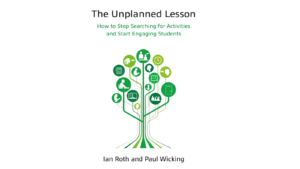What’s Your Teaching Identity? Book Review
Why do English teachers need to have a fully-fledged identity both as professionals and as members of the human race? How does a strong identity help us survive professionally and prevent anxiety, stress and burnout (even shame)? How can we attain a level of integrity that helps us set boundaries while making it easier to decide if an institution’s inherent values are in line with ours, or whether it’s time to quit?
These are just some of the questions that Helen Waldron’s What’s Your Teaching Identity? encourages us to think through. This concise book published in a series by Academic Study Kit is written by an English teacher and a native speaker for that matter; I will explain below why this is important. It is the first book in The Legacy Series and, according to the publisher, Julie Pratten, it aims to bring teacher development to the fore but does it in a nutshell. “They are ‘taster’ books that may lead the reader to investigate that topic in more depth,” said Pratten in a private exchange, adding that these slim and easy-to-read volumes will also make teachers step outside their comfort zones. Further titles in the series are Why Start a Movement? and Why Use Mindmaps?, so it is fair to say that the concept behind it all is looking at the “whys” and not the “hows”.
So, let’s start with doing our homework then. What would be the identity of a Hungarian-born English teacher who learnt English in India, did her degree in Budapest, emigrated to London as a political refugee, worked for the Hungarian Section of the BBC’s World Service churning out dozens of bilingual English by Radio programmes, retired early to teach English in Ethiopia through VSO (Voluntary Service Overseas), lived in Crete and then moved to Ecuador and found a way to volunteer deep in the Amazonian jungle to teach English to members of an isolated indigenous tribe?
One would think that your name is part of your identity. Yet, I was called Erzsi (in Hungary), Elizabeth (in the UK), Elisaki (in Crete) Elsa/Elsi (in Ethiopia, with the sweet variation of Elsiye meaning “my Elsi”), Teacher (in the Amazonian jungle) and these days Eli (in Cuenca). I’d like to believe that all these names refer to one and the same person: a human being and a professional rolled into one, who believes in education and educability as well as in the “hemline”, the invisible thread connecting the heart and the mind, a concept that has now gathered new momentum in the Heart ELT movement. Teach With Your Heart, says Erin Gruwell of The Freedom Writers fame, and most decent teachers (of English or otherwise) do just that.
Waldron describes the situations that English teachers working abroad often face: the insane hours, the shame that might go with the status of being a free-lance teacher (and, by extension, not a proper one), the anxiety that arises when having to teach after not being trained up properly or, at the other extreme, having to pay an arm and a leg for a qualification (Delta comes to mind) that employers are reluctant to acknowledge by promotion and/or higher pay. She comes to the conclusion that a strong identity centres around three elements: a sense of uniqueness, a sense of affiliation and a sense of continuity. Well, in my case, uniqueness has not been a problem so far. In the Ethiopian Ministry of Education, they may still remember the fifty-something white, female volunteer, who sat down on the stairs waiting for an interminable meeting to finish, declaring that she was not going to move until the funding pledged for her English Improvement Programme was released. Affiliation (part of which is identifying with the vision and mission of the institution you work for) could be more of a problem for many of us. More often than not, I stayed on for the same reason as soldiers fighting a war whose rationale they cannot grasp and yet in whose name they are expected to sacrifice themselves: camaraderie.
Continuity is again less of a problem: the ELT industry has been thriving for at least 100 years says Waldron, and it does not seem to have been pushed back by other upcoming languages like Spanish or Mandarin Chinese. If having an identity and retaining your innermost core values is difficult for native speaker English teachers, how much more difficult might it be for non-native English teachers? People swear that I switch to a higher pitch when I speak English and my “natural” Hungarian voice is deeper. Are you a different person in each of the languages you speak or teach? You probably are, because you are functioning in a different linguistic and socio-cultural community. Maybe another slim book of The Legacy Series could explore the “whys” of the professional community of non-native speakers who far outnumber NESTs (Native Speaker English Teachers).
Waldron wonders if there are any role models either for professional development or within the ELT industry to identify with and aspire to. I would say that the independent publisher of this very same series could be looked on as a role model: besides her publishing work, Julie Pratten is a highly creative materials writer and teacher trainer, networker, fundraiser, nudger and does all this with a heart the size of Bournemouth (or perhaps Brighton, where she is based).
As for models of professional development, there are several who resonate with me, first and foremost, Penny Ur. It is not just her extensive output as well as her solid teaching methodology that she displays in the classroom and in her presentations, she is also the most level-headed and pragmatic teacher I have ever met (for decades, only through her books and videos, and then in 2016 in person). Penny is not afraid to share her experience as a novice teacher, describing the mortal fear of entering a class and dealing with a bunch of unruly and disenchanted students – and then, years later, turning it, and other classroom experiences, into the book titled 100 Teaching Tips. She considers that the native – non-native speaker dichotomy is pointless by describing her own example: while she is a native speaker of English, she will never become a native speaker of Hebrew (she moved to Israel in 1967), because, plainly, she is not a native of that land. She perceives herself fully competent in Hebrew and recommends that this is the level that speakers of English as an additional language should strive for in that language. In other words, with English as a lingua franca, it is sufficient to be a fully competent speaker. Or think of Silvana Richardson, the fiery “lady in red” at the IATEFL Birmingham conference of 2016, whose plenary speech reignited the smouldering debate about native and non-native English teachers. As a fully competent speaker of English and a prolific author and guest speaker, who is also Head of Teacher Development at The Bell Foundation, one of her main interests is highlighting and fighting the ongoing bias against non-native speaker teachers, an issue which might be passé as an academic concept for Penny Ur (in all fairness, in her presentation, she was talking about English speakers and not English teachers), but the phenomenon of native speakerism and the values attached to it are still very much alive, as the website TEFL Equity Advocates set up by Marek Kiczkowiak in 2014 clearly testifies.
Helen Waldron’s book is clearly an important one; its length allows busy teachers to read it in one sitting and have the questions linger on in their minds. The notes contain some enticing websites that allow us to delve into transnational cultural identity development and explore our own identity as well as that of the collective community in which we function.
On my FB page, my friends and acquaintances send me messages in Hungarian, English, Spanish, Greek and Amharic with the occasional Russian thrown in. I wonder if they are addressing the same person. An Ethiopian student of mine once said: “Miss Elsi, I learnt two things from you”. “It’s not the end of the world…” and “Life is short.” My essence.
Buy book here
References:
Gruvell, E. (2007). Teach with your Heart. Broadway Books, New York.
Heart ELT founded by Julie Pratten:
http://heartelt.org/
TEFL Equity Advocates:
https://teflequityadvocates.com/
Ur, P. (2012). English as an international language: implications for classroom teaching.
https://www.youtube.com/watch?v=yTidAm0dRR0
Ur, P. (2016). 100 Teaching Tips. Cambridge University Press, Cambridge, England.
Link to sales of the book on Keltic:
http://www.keltic.co.uk/search/index/query/what%27s+your+teaching+identity





2 Responses
Jon Riddle
Nice review. I liked the personal touch.
08/03/2017
Erzsebet Bekes
"Maybe another slim book of the Legacy Series could explore the “whys” of the professional community of non-native speakers who far outnumber NESTs (Native Speaker English Teachers)." You will be pleased to learn that "Why NNESTs?", a short book that I wrote with an Ecuadorian colleague of mine will be published in early April and will be available at the IATEFL Glasgow conference.
08/03/2017